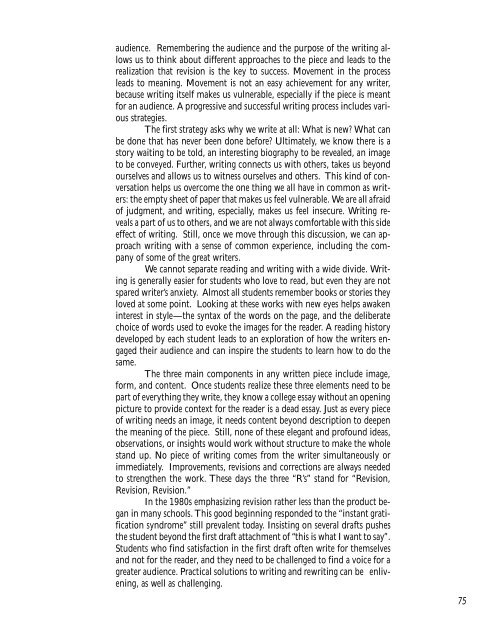Colloquium on English - Research Institute for Waldorf Education
Colloquium on English - Research Institute for Waldorf Education
Colloquium on English - Research Institute for Waldorf Education
You also want an ePaper? Increase the reach of your titles
YUMPU automatically turns print PDFs into web optimized ePapers that Google loves.
audience. Remembering the audience and the purpose of the writing allows<br />
us to think about different approaches to the piece and leads to the<br />
realizati<strong>on</strong> that revisi<strong>on</strong> is the key to success. Movement in the process<br />
leads to meaning. Movement is not an easy achievement <strong>for</strong> any writer,<br />
because writing itself makes us vulnerable, especially if the piece is meant<br />
<strong>for</strong> an audience. A progressive and successful writing process includes various<br />
strategies.<br />
The first strategy asks why we write at all: What is new? What can<br />
be d<strong>on</strong>e that has never been d<strong>on</strong>e be<strong>for</strong>e? Ultimately, we know there is a<br />
story waiting to be told, an interesting biography to be revealed, an image<br />
to be c<strong>on</strong>veyed. Further, writing c<strong>on</strong>nects us with others, takes us bey<strong>on</strong>d<br />
ourselves and allows us to witness ourselves and others. This kind of c<strong>on</strong>versati<strong>on</strong><br />
helps us overcome the <strong>on</strong>e thing we all have in comm<strong>on</strong> as writers:<br />
the empty sheet of paper that makes us feel vulnerable. We are all afraid<br />
of judgment, and writing, especially, makes us feel insecure. Writing reveals<br />
a part of us to others, and we are not always com<strong>for</strong>table with this side<br />
effect of writing. Still, <strong>on</strong>ce we move through this discussi<strong>on</strong>, we can approach<br />
writing with a sense of comm<strong>on</strong> experience, including the company<br />
of some of the great writers.<br />
We cannot separate reading and writing with a wide divide. Writing<br />
is generally easier <strong>for</strong> students who love to read, but even they are not<br />
spared writer’s anxiety. Almost all students remember books or stories they<br />
loved at some point. Looking at these works with new eyes helps awaken<br />
interest in style—the syntax of the words <strong>on</strong> the page, and the deliberate<br />
choice of words used to evoke the images <strong>for</strong> the reader. A reading history<br />
developed by each student leads to an explorati<strong>on</strong> of how the writers engaged<br />
their audience and can inspire the students to learn how to do the<br />
same.<br />
The three main comp<strong>on</strong>ents in any written piece include image,<br />
<strong>for</strong>m, and c<strong>on</strong>tent. Once students realize these three elements need to be<br />
part of everything they write, they know a college essay without an opening<br />
picture to provide c<strong>on</strong>text <strong>for</strong> the reader is a dead essay. Just as every piece<br />
of writing needs an image, it needs c<strong>on</strong>tent bey<strong>on</strong>d descripti<strong>on</strong> to deepen<br />
the meaning of the piece. Still, n<strong>on</strong>e of these elegant and profound ideas,<br />
observati<strong>on</strong>s, or insights would work without structure to make the whole<br />
stand up. No piece of writing comes from the writer simultaneously or<br />
immediately. Improvements, revisi<strong>on</strong>s and correcti<strong>on</strong>s are always needed<br />
to strengthen the work. These days the three “R’s” stand <strong>for</strong> “Revisi<strong>on</strong>,<br />
Revisi<strong>on</strong>, Revisi<strong>on</strong>.”<br />
In the 1980s emphasizing revisi<strong>on</strong> rather less than the product began<br />
in many schools. This good beginning resp<strong>on</strong>ded to the “instant gratificati<strong>on</strong><br />
syndrome” still prevalent today. Insisting <strong>on</strong> several drafts pushes<br />
the student bey<strong>on</strong>d the first draft attachment of “this is what I want to say”.<br />
Students who find satisfacti<strong>on</strong> in the first draft often write <strong>for</strong> themselves<br />
and not <strong>for</strong> the reader, and they need to be challenged to find a voice <strong>for</strong> a<br />
greater audience. Practical soluti<strong>on</strong>s to writing and rewriting can be enlivening,<br />
as well as challenging.<br />
75

















